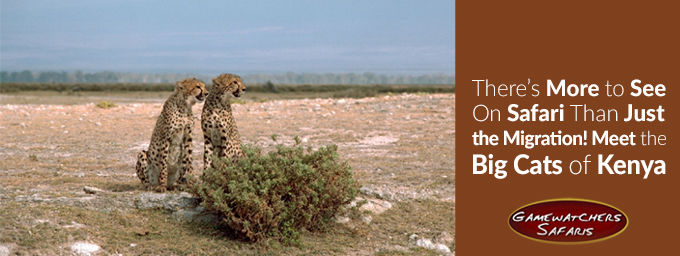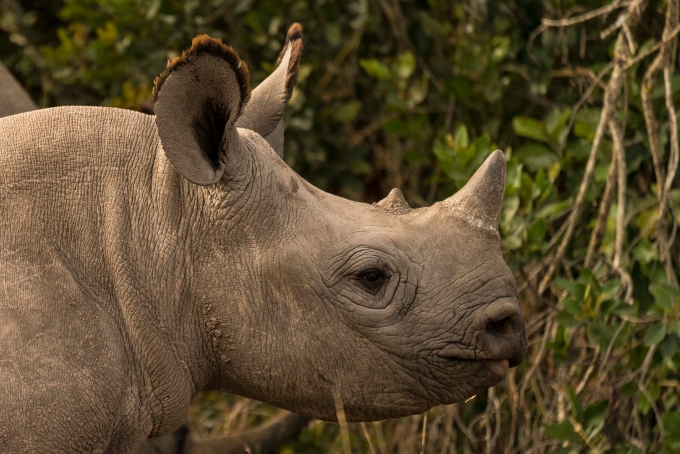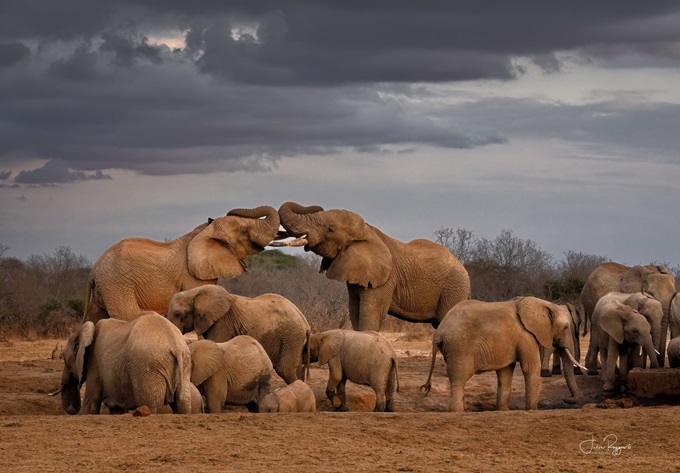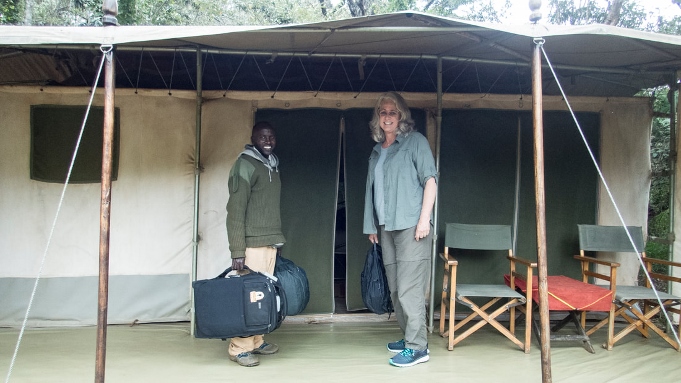
Many who travel to Kenya on safari hope to see the Great Migration—Africa’s own “Amazing Race”. But if you’re looking to see some awesome animal action, you don’t have to safari during particular months to witness it. The Big Cats of Kenya are a year-round attraction.
Between the stalking lioness, who exudes some serious girl power, and the racing cheetah, who breaks the record for fastest animal on land, you really get the best show on earth no matter when you visit. Meet them, and the other big cats of Kenya.
You can’t travel to Africa and miss seeing the mighty lion!

Why go all the way to Kenya and not see the King of the Jungle? The lion is Africa’s most iconic big cat and for good reason. It is part of the “Big Five” and has been represented in countless films, television shows, and even a famous broadway production.
Habitat

In daylight, lions can be found lying in the shade of an acacia tree or basking in the golden sun on the African savannah. They are the only big cat that lives in groups, which are called prides. In each pride, there are only one to three males as opposed to many lionesses. Lion cubs stay with their pride until they are fully mature; however, once a male cub is fully grown, he must set off to start his own pride, often fighting to take over a pre-existing one.
While on safari in Kenya, look out for lions in the Mara and Mara Conservancies. During the day, you will see them lounging around the grasslands or perhaps giving junior a bath. But the real excitement comes when the lioness is on the hunt.
Hunting/Prey Behaviors

The warriors of the pride are the females. They are the best at stalking, catching, and killing their prey. Lionesses hunt in groups—it’s easier to make a kill when there are multiple mouths in the mix. Their prey varies depending on what is available, but often, it consists of wildebeest, zebra, antelope, buffalo, and other large game on the savannah. As lions are not very fast, it helps to work together to trap the prey.
Lion cubs do not typically start learning how to hunt until they are at least a year old. Lionesses make sure to teach the proper technique when killing their prey so that by the time the cubs are two years old, they can be an asset to the pride.
While male lions are not part of the hunting party, that doesn’t mean they don’t have a job. Male lions act as guardians for the pride, constantly protecting their territory and families from intruders. Loud roars act as a first warning, and should an attack be necessary, they are ready for a fight.
Endangered Status

The African lion is listed as “vulnerable,” but great efforts are being made to save this magnificent mammal. At Ol Kinyei Conservancy, lions find a safe haven to increase their dwindling population. Conservancies allow animals to roam freely in the wild, but in an area that is set aside as their habitat and protected by the presence of Wardens and Rangers.
Even though lions are not restricted behind fences in the parks and conservancies, research shows they spend the majority of their time in them. And by staying in eco-camps, you are helping to fund those who run the conservancies so that they can continue to help these beautiful beasts.
Be on the look out for the ever elusive Leopard.

The leopard is certainly the most elegant of all the African big cats. Just take a look at its luxuriously spotted coat. But the leopard’s fur isn’t meant to be glamorous—it actually helps the fashionable feline blend in while hunting on the savannah.
Habitat

Unlike lions, leopards are solitary creatures. Leopards are skilled climbers—during the day, you can often find them lounging on a tree branch or cooling off near a watering hole. The big cat is incredibly adaptable. On an African safari, you can find leopards in many different types of habitats: rocky mountains, dense forests, and vast grasslands.
The best time to see a leopard is at night, on a sundowner safari. That is when the action begins…
Hunting/Prey Behaviors
Leopards are most active at night, between sundown and sun-up, hunting for a variety of prey. On land, leopards hunt everything from the smaller reptiles and rodents to the larger impala and antelope. They will take their kill up into the trees in order to keep other scavengers, like hyenas, from stealing their meal.
While successful on land, leopards are also skilled swimmers. They feed upon fish, crabs, and other freshwater creatures. So much for cats not liking to get wet!
Endangered Status

Hunted for their attractive spotted coat, leopards have seen a decline over the past decades and are now considered “vulnerable.” But it isn’t only because of illegal poaching that the big cat has decreased in population. Every day, leopards are losing their habitats, and subsequently, prey that is also losing its habitat. Conservancies like Ol Kinyei and Olare Motorogi help to protect their environments so that the leopard can once again largely populate Africa.
With that kind of speed, it’s always chow-time for the Cheetah.

Can you imagine being able to run at 70 miles per hour? The cheetah can. In fact, this big cat holds the record as the fastest animal on land. Make sure to lookout for a blur of brown spots as it races by!
Habitat

Cheetahs live on the grasslands of Africa, blending in with their surroundings thanks to their spotted coats. Cheetahs can be found in many of the conservancies and parks, including Ol Pejeta Conservancy.
Socially, cheetahs fall between the leopard and the lion—neither solitary nor incredibly social. You may see a few of the big felines together while on safari.
Hunting/Prey Behavior
Speed allows them to catch the great sprinters of the savannah, such as gazelles, antelopes, and impalas. Once it grabs hold of its prey, a cheetah clenches its jaws around the kill’s neck. After sprinting at top speeds of 70 miles per hour, the fast and furious feline needs at least 20 minutes of recovery time before it can begin to eat. But it must hurry before hyenas or other thieves come in on the meal.
Endangered Status

Just like the other big cats of Africa, the cheetah is currently listed as “vulnerable” for a variety of reasons. Cheetahs have notoriously been hunted for their spotted fur. While poaching is illegal these days, humans break the law all the time.
There is still time to save the cheetah. Through education programs and supporting local communities that protect the big cats, you can ensure that this marvelous mammal is here for years and years to come.
If you’re a big fan of Africa’s big cats, check out the other felines of the savannah!
Besides the three big cats of the African savannah, three smaller cats can be seen while on safari in Kenya. The serval, caracal, and African wild cat all exist in the Selenkay Conservancy. Thankfully, all three of these felines are of “least concern” on the list of threatened species.
Serval Cat

Photo by Patrice Alsteen
Imagine crossing a house-cat with a cheetah. Add some pointy ears and you’ve got a serval. Beautifully spotted, but oddly shaped, the serval roams the savannah, mainly near sources of water. They are solitary cats, only social during mating season.
Those big ears? They are used to hear prey running through the grass or even underground. Sometimes servals don’t even see their prey until they are pouncing on it! Night is the best time to see these peculiar kitties in action, so make sure to schedule a night game drive!
Caracal

Another of the smaller cats of Kenya is the caracal. Like the serval, this feline is known for its ears—black “tufts” of fur stick straight up from the tops of both ears. A typical cat, caracals prefer to be alone, often going days at a time without seeing another of its kind.
Wings are no match for the crafty caracal! Even though it’s small (about 40 lbs), the caracal can jump after birds, up to six feet in the air. Don’t miss out on seeing this ninja of a cat while on safari.
African Wild Cat
Want to know where your cat, Felix, comes from? Look no further than the African wild cat, ancestor of the domestic cat. During the day, African wild cats hide among the tall grass and bushes, but at night, they are ready to prowl the savannah. The petite feline pounces upon mice, rats, birds, reptiles, and other small animals.
Ready to see these fascinating felines for yourself?
No matter when you book your Kenya safari holiday, if you stay at the right camps then you will have an excellent chance of seeing many of the iconic big cats wandering the grasslands. Get in touch to start planning the trip of a lifetime.
Or, if you are still researching your options then sign up for our free 6-part How to Book A Safari email series and discover how to make the most out of your time and budget.
on Monday 21st August 2017 at 03:37







